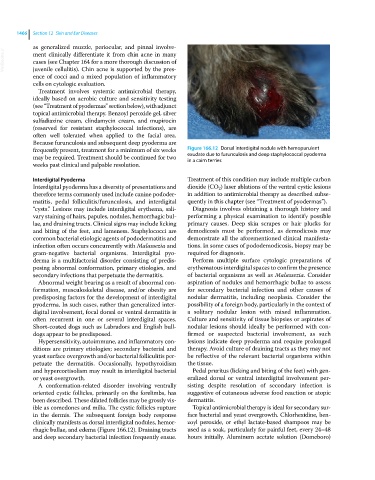Page 1528 - Clinical Small Animal Internal Medicine
P. 1528
1466 Section 12 Skin and Ear Diseases
as generalized muzzle, periocular, and pinnal involve-
VetBooks.ir ment clinically differentiate it from chin acne in many
cases (see Chapter 164 for a more thorough discussion of
juvenile cellulitis). Chin acne is supported by the pres-
ence of cocci and a mixed population of inflammatory
cells on cytologic evaluation.
Treatment involves systemic antimicrobial therapy,
ideally based on aerobic culture and sensitivity testing
(see “Treatment of pyodermas” section below), with adjunct
topical antimicrobial therapy. Benzoyl peroxide gel, silver
sulfadiazine cream, clindamycin cream, and mupirocin
(reserved for resistant staphylococcal infections), are
often well tolerated when applied to the facial area.
Because furunculosis and subsequent deep pyoderma are
frequently present, treatment for a minimum of six weeks Figure 166.12 Dorsal interdigital nodule with hemopurulent
may be required. Treatment should be continued for two exudate due to furunculosis and deep staphylococcal pyoderma
in a cairn terrier.
weeks past clinical and palpable resolution.
Interdigital Pyoderma Treatment of this condition may include multiple carbon
Interdigital pyoderma has a diversity of presentations and dioxide (CO 2 ) laser ablations of the ventral cystic lesions
therefore terms commonly used include canine pododer- in addition to antimicrobial therapy as described subse-
matitis, pedal folliculitis/furunculosis, and interdigital quently in this chapter (see “Treatment of pyodermas”).
“cysts.” Lesions may include interdigital erythema, sali- Diagnosis involves obtaining a thorough history and
vary staining of hairs, papules, nodules, hemorrhagic bul- performing a physical examination to identify possible
lae, and draining tracts. Clinical signs may include licking primary causes. Deep skin scrapes or hair plucks for
and biting of the feet, and lameness. Staphylococci are demodicosis must be performed, as demodicosis may
common bacterial etiologic agents of pododermatitis and demonstrate all the aforementioned clinical manifesta-
infection often occurs concurrently with Malassezia and tions. In some cases of pododemodicosis, biopsy may be
gram‐negative bacterial organisms. Interdigital pyo- required for diagnosis.
derma is a multifactorial disorder consisting of predis- Perform multiple surface cytologic preparations of
posing abnormal conformation, primary etiologies, and erythematous interdigital spaces to confirm the presence
secondary infections that perpetuate the dermatitis. of bacterial organisms as well as Malassezia. Consider
Abnormal weight bearing as a result of abnormal con- aspiration of nodules and hemorrhagic bullae to assess
formation, musculoskeletal disease, and/or obesity are for secondary bacterial infection and other causes of
predisposing factors for the development of interdigital nodular dermatitis, including neoplasia. Consider the
pyoderma. In such cases, rather than generalized inter- possibility of a foreign body, particularly in the context of
digital involvement, focal dorsal or ventral dermatitis is a solitary nodular lesion with mixed inflammation.
often recurrent in one or several interdigital spaces. Culture and sensitivity of tissue biopsies or aspirates of
Short‐coated dogs such as Labradors and English bull- nodular lesions should ideally be performed with con-
dogs appear to be predisposed. firmed or suspected bacterial involvement, as such
Hypersensitivity, autoimmune, and inflammatory con- lesions indicate deep pyoderma and require prolonged
ditions are primary etiologies; secondary bacterial and therapy. Avoid culture of draining tracts as they may not
yeast surface overgrowth and/or bacterial folliculitis per- be reflective of the relevant bacterial organisms within
petuate the dermatitis. Occasionally, hypothyroidism the tissue.
and hypercortisolism may result in interdigital bacterial Pedal pruritus (licking and biting of the feet) with gen-
or yeast overgrowth. eralized dorsal or ventral interdigital involvement per-
A conformation‐related disorder involving ventrally sisting despite resolution of secondary infection is
oriented cystic follicles, primarily on the forelimbs, has suggestive of cutaneous adverse food reaction or atopic
been described. These dilated follicles may be grossly vis- dermatitis.
ible as comedones and milia. The cystic follicles rupture Topical antimicrobial therapy is ideal for secondary sur-
in the dermis. The subsequent foreign body response face bacterial and yeast overgrowth. Chlorhexidine, ben-
clinically manifests as dorsal interdigital nodules, hemor- zoyl peroxide, or ethyl lactate‐based shampoos may be
rhagic bullae, and edema (Figure 166.12). Draining tracts used as a soak, particularly for painful feet, every 24–48
and deep secondary bacterial infection frequently ensue. hours initially. Aluminum acetate solution (Domeboro)

